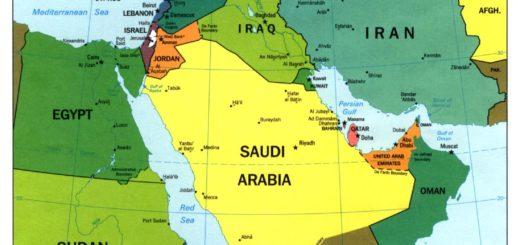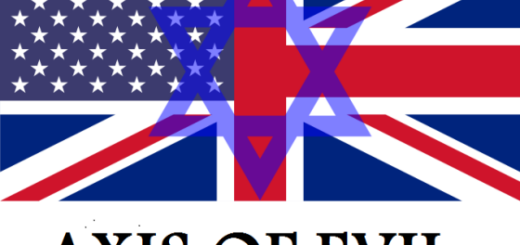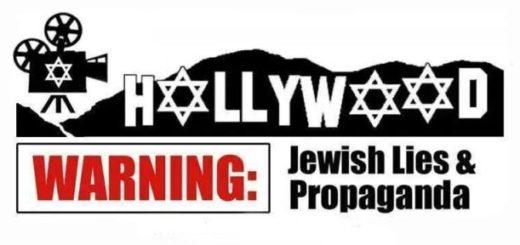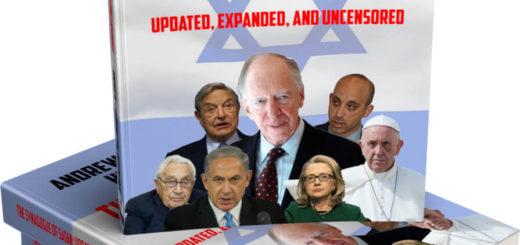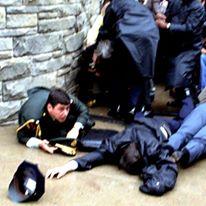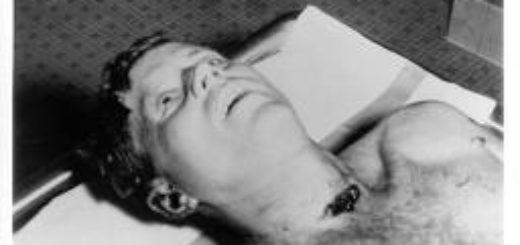$26 TRILLION in Bankster Bailouts-Alan Grayson
“26 TRILLION Dollars In Bank Bailouts! That’s Not Including TARP!” Alan Grayson

My Comment: Now you know why the Media was so determined to take him down with really bad press during his divorce-he was exposing Bankster crimes & Fraud and they are the Rothschild Banks who control what goes into our Media through their hack Rupert Murdoch. BTW the taxpayers paid yet got almost no bailout-maybe 1% with their own money. Not surprisingly youtube has censored this video.
20TH APR 2016 | 9 NOTES



Let me tell you about my successful effort to audit the Federal Reserve. Wall Street didn’t like losing to me on that one.
Yesterday, I explained that the Democratic Primary for the U.S. Senate this year represents a “twofer” for Wall Street: Wall Street can try to elect its errand boy, Patrick Murphy, at the same time as it goes medieval on me for passing my “Pay for Performance Act,” which prevented Wall Street from pocketing federal bailout money.
But there’s more.
In 2009, in the midst of bailout mania, I powered the 30-year-old effort to audit the Federal Reserve, which controls our money supply. The Federal Reserve had never had any independent audit in its 100-year history. Rep. Ron Paul (R-TX) had first sought an audit when I was still in graduate school, but his bill hadn’t even gotten a hearing, much less a vote. Yet “the Fed” clearly was taking an active role in the bailouts – it’s just that no one knew what that role was.
I patiently signed up more than 100 Democratic Members of Congress, one by one, to cosponsor the “Audit the Fed” bill. Then I steered it through the Financial Services Committee, and on the Floor of the House. Then I rescued it from a Wall Street counterattack in the Dodd-Frank Conference Committee.
Secretary Tim Geithner, Wall Street’s man in the Obama Administration, said that his number-one priority in Dodd-Frank was not to save the world economy, but rather to strike that audit from the bill. But I won. And Wall Street lost.
The audit found $26 trillion in secret bailouts to financial institutions. That’s $26,000,000,000,000.00. You can read about it here.
Wall Street was very unhappy. Five years later, they remain unhappy. That’s one reason why they’ve given my primary opponent more sewer money than any other House Democrat.
If you want Wall Street to continue to dictate our economic policies, driving us deeper and deeper into debt slavery, then just do nothing. In fact, you can stop reading this e-mail right now.
Alternatively, you can contribute to our Senate campaign, right here and right now, knowing that you are supporting the one Democrat (other than Elizabeth Warren) who is ready, willing and able to stand up for you against the power of Big Money – because that’s what I’ve done already. And won. Twice.
Courage,
Rep. Alan Grayson
- oliveria-fan liked this
- twowaypr reblogged this from cumberbees
- twowaypr liked this
- cumberbees liked this
- cumberbees reblogged this from alangraysonemails
- flaneurdujour liked this
- yodwynn liked this
- daniellevyas reblogged this from alangraysonemails
- larryang0 reblogged this from alangraysonemails
- alangraysonemails posted this
Fmr. Rep. Alan Grayson, ContributorFormer U.S. Congressman for Orlando, Florida
The Fed Bailouts: Money for Nothing
12/05/2011 02:54 pm ET Updated Feb 04, 2012
I think it’s fair to say that Congressman Ron Paul and I are the parents of the GAO’s audit of the Federal Reserve. And I say that knowing full well that Dr. Paul has somewhat complicated views regarding gay marriage.
Anyway, one of our love children is a massive 251-page GAO report technocratically entitled “Opportunities Exist to Strengthen Policies and Processes for Managing Emergency Assistance.” It is almost as weighty as that 13-lb. baby born in Germany last week, named Jihad. It also is the first independent audit of the Federal Reserve in the Fed’s 99-year history.
Feel free to take a look at it yourself, it’s right here. It documents Wall Street bailouts by the Fed that dwarf the $700 billion TARP, and everything else you’ve heard about.
I wouldn’t want anyone to think that I’m dramatizing or amplifying what this GAO report says, so I’m just going to list some of my favorite parts, by page number.
Page 131 – The total lending for the Fed’s “broad-based emergency programs” was $16,115,000,000,000. That’s right, more than $16 trillion. The four largest recipients, Citigroup, Morgan Stanley, Merrill Lynch and Bank of America, received more than a trillion dollars each. The 5th largest recipient was Barclays PLC. The 8th was the Royal Bank of Scotland Group, PLC. The 9th was Deutsche Bank AG. The 10th was UBS AG. These four institutions each got between a quarter of a trillion and a trillion dollars. None of them is an American bank.
Pages 133 & 137 – Some of these “broad-based emergency program” loans were long-term, and some were short-term. But the “term-adjusted borrowing” was equivalent to a total of $1,139,000,000,000 more than one year. That’s more than $1 trillion out the door. Lending for these programs in fact peaked at more than $1 trillion.
Pages 135 & 196 – Sixty percent of the $738 billion “Commercial Paper Funding Facility” went to the subsidiaries of foreign banks. 36% of the $71 billion Term Asset-Backed Securities Loan Facility also went to subsidiaries of foreign banks.
Page 205 – Separate and apart from these “broad-based emergency program” loans were another $10,057,000,000,000 in “currency swaps.” In the “currency swaps,” the Fed handed dollars to foreign central banks, no strings attached, to fund bailouts in other countries. The Fed’s only “collateral” was a corresponding amount of foreign currency, which never left the Fed’s books (even to be deposited to earn interest), plus a promise to repay. But the Fed agreed to give back the foreign currency at the original exchange rate, even if the foreign currency appreciated in value during the period of the swap. These currency swaps and the “broad-based emergency program” loans, together, totaled more than $26 trillion. That’s almost $100,000 for every man, woman, and child in America. That’s an amount equal to more than seven years of federal spending — on the military, Social Security, Medicare, Medicaid, interest on the debt, and everything else. And around twice American’s total GNP.
Page 201 – Here again, these “swaps” were of varying length, but on Dec. 4, 2008, there were $588,000,000,000 outstanding. That’s almost $2,000 for every American. All sent to foreign countries. That’s more than twenty times as much as our foreign aid budget.
Page 129 – In October 2008, the Fed gave $60,000,000,000 to the Swiss National Bank with the specific understanding that the money would be used to bail out UBS, a Swiss bank. Not an American bank. A Swiss bank.
Pages 3 & 4 – In addition to the “broad-based programs,” and in addition to the “currency swaps,” there have been hundreds of billions of dollars in Fed loans called “assistance to individual institutions.” This has included Bear Stearns, AIG, Citigroup, Bank of America, and “some primary dealers.” The Fed decided unilaterally who received this “assistance,” and who didn’t.
Pages 101 & 173 – You may have heard somewhere that these were riskless transactions, where the Fed always had enough collateral to avoid losses. Not true. The “Maiden Lane I” bailout fund was in the hole for almost two years.
Page 4 – You also may have heard somewhere that all this money was paid back. Not true. The GAO lists five Fed bailout programs that still have amounts outstanding, including $909,000,000,000 (just under a trillion dollars) for the Fed’s Agency Mortgage-Backed Securities Purchase Program alone. That’s almost $3,000 for every American.
Page 126 – In contemporaneous documents, the Fed apparently did not even take a stab at explaining why it helped some banks (like Goldman Sachs and Morgan Stanley) and not others. After the fact, the Fed referred vaguely to “strains in the financial markets,” “transitional credit,” and the Fed’s all-time favorite rationale for everything it does, “increasing liquidity.”Subscribe to The Morning Email.Wake up to the day’s most important news.
81 different places in the GAO report – The Fed applied nothing even resembling a consistent policy toward valuing the assets that it acquired. Sometimes it asked its counterparty to take a “haircut” (discount), sometimes it didn’t. Having read the whole report, I see no rhyme or reason to those decisions, with billions upon billions of dollars at stake.
Page 2 – As massive as these enumerated Fed bailouts were, there were yet more. The GAO did not even endeavor to analyze the Fed’s discount window lending, or its single-tranche term repurchase agreements.
Pages 13 & 14 – And the Fed wasn’t the only one bailing out Wall Street, of course. On top of what the Fed did, there was the $700,000,000,000 TARP program authorized by Congress (which I voted against). The Federal Deposit Insurance Corp. (FDIC) also provided a federal guarantee for $600,000,000,000 in bonds issued by Wall Street.
There is one thing that I’d like to add to this, which isn’t in the GAO’s report. All this is something new, very new. For the first 96 years of the Fed’s existence, the Fed’s primary market activities were to buy or sell U.S. Treasury bonds (to change the money supply), and to lend at the “discount window.” Neither of these activities permitted the Fed to play favorites. But the programs that the GAO audited are fundamentally different. They allowed the Fed to choose winners and losers.
So what does all this mean? Here are some short observations:
(1) In the case of TARP, at least The People’s representatives got a vote. In the case of the Fed’s bailouts, which were roughly 20 times as substantial, there was never any vote. Unelected functionaries, with all sorts of ties to Wall Street, handed out trillions of dollars to Wall Street. That’s now how a democracy should function, or even can function.
(2) The notion that this was all without risk, just because the Fed can keep printing money, is both laughable and cryable (if that were a word). Leaving aside the example of Germany’s hyperinflation in 1923, we have the more recent examples of Iceland (75% of GNP gone when the central bank took over three failed banks) and Ireland (100% of GNP gone when the central bank tried to rescue property firms).
(3) In the same way that American troops cannot act as police officers for the world, our central bank cannot act as piggy bank for the world. If the European Central Bank wants to bail out UBS, fine. But there is no reason why our money should be involved in that.
(4) For the Fed to pick and choose among aid recipients, and then pick and choose who takes a “haircut” and who doesn’t, is both corporate welfare and socialism. The Fed is a central bank, not a barber shop.
(5) The main, if not the sole, qualification for getting help from the Fed was to have lost huge amounts of money. The Fed bailouts rewarded failure, and penalized success. (If you don’t believe me, ask Jamie Dimon at JP Morgan.) The Fed helped the losers to squander and destroy even more capital.
(6) During all the time that the Fed was stuffing money into the pockets of failed banks, many Americans couldn’t borrow a dime for a home, a car, or anything else. If the Fed had extended $26 trillion in credit to the American people instead of Wall Street, would there be 24 million Americans today who can’t find a full-time job?
And here’s what bothers me most about all this: it can happen again. I’ve called the GAO report a bailout autopsy. But it’s an autopsy of the undead.
Courage,
Alan Grayson




